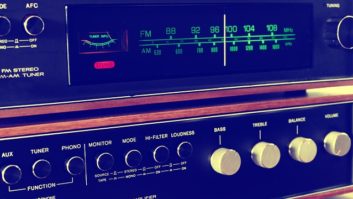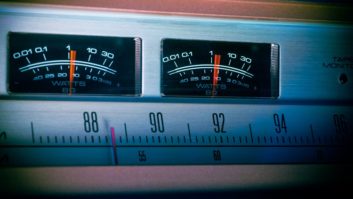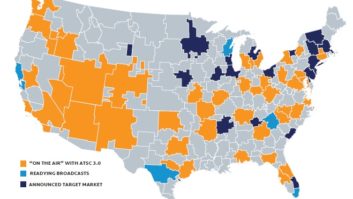“Some say that the apocalypse is about to begin,” said Tom Ray, vice president and corporate director of engineering for Buckley Broadcasting.
“I’m the one who will be starting it.”
That would be when Ray, an outspoken advocate of AM HD Radio who is also an RW contributor, keeps the HD-R signal of the powerful 50 kW WOR 710HD in New York on the air at night and skywave effect takes his embedded digital signal hundreds of miles outside the designated service area along with the analog stream.
This, many observers believe, will undoubtedly create increased interference with first-adjacent and second-adjacent analog stations by the digital channels along the way.
Nighttime AM HD-R
Until the FCC approved so-called “final” rules for in-band, on-channel digital radio broadcasting in the United States, an AM station broadcasting a digital signal was not allowed to keep it on at night for that very reason: potential interference issues.
But in approving the rules in March and allowing nighttime AM HD-R to take effect soon, the commission made it clear that stations that seek HD interference relief — as allowed under the new rules in something of a compromise on the interference issue — will not find much sympathy if that interference falls outside the protected contour listening area.
To call the debate around the AM HD-R interference issue a firestorm would be putting it mildly.
(click thumbnail)Bobby Gray at his facility in Orlando.“I’m avoiding real-time conversations with my colleagues as these conversations are absolutely 100-percent polarized,” said Bobby Gray, operations manager and chief engineer for AM stations WHOO and WAMT in Orlando, Fla. WHOO is 19 kW daytime at 1080, and WAMT is 5 kW daytime/230W nighttime at 1190.
“Either they are for this, or they are against this. I am choosing to read everything I can get my hands on about the subject and hold my opinions for Radio World interviews where I cannot be instantly (thrown) under the bus or in a four-hour IBOC-bashing session,” Gray said.
“This is a hot topic, and the opinions are plentiful. If there are call letters involved, there is an opinion.”
Positives, negatives
Gray is not against digital broadcasting for AM, despite his strong convictions about the current rollout.
“I really do like how it sounds,” he said.
“Tom Ray’s HD Web page (had) an audio file on it of him driving out of one of the New York City tunnels, and when the audio switches to HD it is (like) night and day, and sounds better than AM has sounded in years.”
But Gray has strong reservations about such issues as upper- and lower-channel interference with an IBOC AM HD transmitting system, such as the Ibiquity system being used by U.S. radio.
“If it (AM HD-R) would sound like this,” he said, referring to Ray’s sampling of WOR in New York, “without all the related issues … I would be wearing an IBOC T-shirt 24/7.”
Gray, whose company is all AM, said he is “shocked” at what he considers the industry ignoring the “elephant in the living room” regarding the noise and potential interference and only “chattering” about the positives of AM HD-R.
“There are positives. I agree,” he said. “(But) there are some damn nasty negatives, and that just isn’t being talked about.”
NRSC standard abated
In particular, Gray does not understand why after establishing the NRSC AM preemphasis/deemphasis and broadcast audio transmission bandwidth specifications to reduce interference on analog AM in the late 1980s, the industry would seemingly go along with a digital system that he said creates data noise.
(click thumbnail)Jerry Arnold in the WMGI(FM) control room.“Am I missing something?” Gray said.
Ray, who also is writing a book for Focal Press and the Society of Broadcast Engineers about HD Radio implementation, was part of the AM HD-R nighttime industry testing at WOR. In addition Buckley Broadcasting has four AMs in the Hartford, Conn., area; two in Syracuse, N.Y.; one in Bakersfield, Calif., and one in Monterey-Salinas, Calif.
“The sky is not falling, though skywave reception will be iffy for the analog signal,” Ray said.
Within the station’s 0.5 mV/m coverage area, the analog is “pretty clean,” he said, though there is “some hiss” under the audio on the fringe.
“Once you get into skywave territory, it’s pretty much a crapshoot — but so is present-day skywave reception,” Ray said. “In the test we did, it is interesting to note that skywave reception was just as noisy and unpredictable with the adjacent station’s HD carriers off as it was with them on.
“So where’s the problem?”
Ray said he does not believe the average listener is going to notice much difference, with the exception of “a few cases” that Ibiquity has identified.
“The AM landscape is changing, like it or not,” Ray said. “Change sometimes is not comfortable.”
Up but turned off
At Cox Radio, one of the industry’s largest radio broadcast groups with 67 FM and 13 AM stations, and where HD is considered a priority, AM HD-R has been turned off at the three or four stations that are outfitted, said Sterling Davis, vice president of engineering.
(click thumbnail)Sterling Davis of Cox Radio“Once we had several of our stations up and working, we have turned around and shut them off,” he said.
Davis explained that Cox discovered that radios in Chrysler and Mercedes automobiles are designed with wide front ends and that there is “some faint buzz” in the background digital carriers.
“We are not willing to compromise signal quality on those products,” he said.
The problem, Davis said, is with the digital scheme of the Ibiquity system.
The respective RF chains at the Cox stations have been investigated by the transmitter supplier Harris and by Ibiquity.
“Ibiquity acknowledges the problem and claims to be working on a solution,” he said. “So until Ibiquity solves that issue, we are keeping those stations off the air.”
Vicki Stearn, director of corporate communications at Ibiquity, told RW “a few” car radios, mainly in the Daimler-Chrysler family, were produced with “wide-band” receivers, which picked up a broader portion of the spectrum than standard analog radios.
“Unfortunately, that included some of the spectrum used by HD Radio broadcasts, therefore, the hum,” Stearn said. “To our knowledge, a few wide-band receivers were sold, and these radios are no longer being manufactured. Therefore, this is not a serious issue.”
Davis said he is unaware of a similar situation with other radios on the market. But even so, he said, “We are not willing to compromise the existing stations for the sake of a very few listeners.”
A proponent of AM HD-R, Davis said he believes implementation is going well.
“I think it is probably a B+,” he said. “It makes a difference when you have it on.”
Davis said the new technology allows stations to have new avenues and options for revenue.
“I don’t think every station will automatically avail themselves to that option,” he said, “or they may choose to do something else. (But) it certainly makes the options available.”
No doubt of ‘impact’
Cox is the owner of clear-channel WSB in Atlanta, a well-known station heard at nighttime via skywave. Cox took no position during the FCC IBOC proceedings on whether to lift the nighttime restrictions.
Davis said nighttime AM HD-R will have an impact: interference.
“It is going to be case-by-case related and station-by-station related,” he said. “I don’t think there is a universal answer. The answer is that many stations will be impacted. The question that remains, and why we are not taking a position on it: Does it hurt those stations or not?”
Davis said nighttime broadcasting will particularly affect small stations that may not cover their whole markets that well.
At Crawford Broadcasting, which owns 15 AMs and 11 FMs, the AM HD Radio rollout is well underway, with all but two AM broadcasting in digital, and those are expected to go online next year.
(click thumbnail)Contract engineer Kevin Berlen“Within our company, we restored several AM stations to music formats because we can now offer good fidelity via HD Radio,” said Cris Alexander, director of corporate engineering for Crawford and an RW contributor.
While pushing ahead with AM HD-R, Alexander, like Davis, said the impact will be interference at a certain level.
“There will be virtually no impact within the 2 mV/m ‘metro grade’ and very little within the 0.5 mV/m protected contour where no grandfathered overlap exists,” Alexander said.
But, he continued, there “likely” will be “some” interference outside the protected contour, “perhaps in areas where some stations now enjoy ‘coverage’ but are not entitled to protection from interference.”
Alexander said the situation at night could be different.
“But again, I anticipate very little impact within stations’ ‘interference-free’ contours,” he said.
The nighttime impact likely will come, Alexander explained, in areas outside the “interference-free” (50 percent RSS) contour, especially for stations that have secondary nighttime service — for example those stations that are otherwise Class D and that do not receive protection from interference at night.
“But this remains to be seen,” he said.
Some exceptions
One exception to all this, Alexander said, is where there is a high-power third-adjacent channel AM HD-R within the primary coverage area of another station.
Even if that digital station has its +/- 25 kHz spectral regrowth products down 65 dBc or lower, he continued, those can produce a high field strength within the other station’s coverage area within a few miles of the digital station’s antenna, effectively “poking a hole” in the affected station’s coverage area.
“In such situations, stations will have to cooperate by reducing digital sideband power or installing filters to reduce radiation of the unwanted products,” Alexander said.
Car receivers
Like FM, or a Bad Internet Stream?Cris Alexander of Crawford Broadcasting offered suggestions for AM stations to obtain the best quality digital broadcasts.
While much has been made of the requirement for meeting the “IBOC spec” for bandwidth of AM antenna systems, perhaps the bigger issue is proper load symmetry and orientation. Crawford has made stations with +/-15 kHz sideband VSWR values in excess of 2.2:1 work just fine in the digital mode as long as the load is symmetrical and properly oriented. Orientation tends to be hyper-critical in such situations.
Other factors that contribute to good performance are good source material because AM HD-R does not play well with high-compression-rate audio streams; high-bandwidth/low- or no-compression STL; and careful attention to processor settings.
“You can make AM HD-R sound truly FM-like,” Alexander said, “with good attention to details: proper load symmetry/orientation, low-compression/high data rate source material, high-bandwidth/low-compression or linear STL and careful processing.
“You can otherwise, with very little effort, make it sound really bad.
“It can sound like a bad Internet stream.”Like Davis at Cox, Alexander has run into problems with automobile radios, specifically with aftermarket units.
Hondas in particular have “poor” AM antennas, he said, usually a rear-window horizontal wire incorporated into, but electrically isolated from, the defogger. These antennas do not provide enough signal for proper AM HD-R decoding of any but the strongest signals, he continued.
Ibiquity, in cooperation with its receiver manufacturing partners, will have to address this by some means, providing preamps for such installations or increasing receiver sensitivity, Alexander said.
A “well-engineered” AM HD-R station will provide reliable digital coverage out to roughly the 1 mV/m contour in most cases — no grandfathered overlap or local interference.
“This is adequate, but without a good external antenna, it may take 30 mV/m or more to achieve acceptable digital reception performance,” he said.
Stearn said Ibiquity suspects the installer bypassed the amplifiers for the AM antennas in the Honda cars when factory-installed head units were replaced with aftermarket products.
“If installed completely, the aftermarket radio should properly decode the HD Radio signal,” she said. “But, again, we do not know which radio was installed in which configuration of a Honda automobile to be certain that this is the issue here.”
Alexander said his group has searched for the antenna amplifier and cannot find it or how it is powered — or if it exists. Alexander said they are working on other aspects to try to solve the situation.
Trouble ahead?
Some AM HD-R opponents see nothing but trouble ahead for the band with the current digital scheme.
Jerry Arnold, director of the Terre Haute, Ind., market for Midwest Communications that owns one AM and two FMs there, said AM IBOC will be the “death knell” for small to medium markets if the FCC ever goes as far as mandating the system, which it did not do in its recent IBOC rules.
His station, WPRS(AM), is a 1 kW daytime/250W nighttime nondirectional at 1440 kHz.
“It will end up costing listeners, since the ‘big boys’ who have IBOC will ‘bleed’ on the little guys, causing intense interference with result of losing listeners for the little guys,” he said.
Arnold, with 40 years experience in broadcasting, also does not think much of AM HD-R as it currently stands.
“The 5 kHz ‘kinda-analog’ remnant, in many cases, reminds me — and to others to whom I have spoken — of a telephone conversation,” he said. “The first- and second-adjacent ‘rushing noise’ in a standard receiver blankets a lot farther away than on might think.”
Kevin Berlen, a 23-year engineering veteran and a contract engineer for a 250 W daytimer and a 1 kW day/250W nighttime station, is in the same camp.
“The biggest problem I have with the technology is the total disregard for the NRSC curve that we have been operating under for many years now,” he said.
The NRSC system implemented to help reduce AM interference is not perfect, he said, but it mitigated a great number of the interference issues.
“AM IBOC totally blows this foundation away,” Berlen said. “It is astonishing to me that AM stereo was implemented over two decades ago and with minimal impact on adjacents.
“With today’s technology, we should have been able to do better.”













